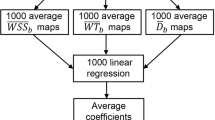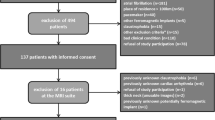Abstract
We evaluated an MRI protocol at 3 T for the assessment of morphological and functional properties of the common carotid artery (CCA) in 32 healthy volunteers and 20 patients with high-grade internal carotid artery stenosis. Wall thickness of the CCA was measured by using multislice 2D T2 dark blood fast spin echo sequences and compared with intima-media thickness (IMT) determined by ultrasound. Carotid distensibility coefficient (DC) quantified by blood pressure and CCA diameter change during the cardiac cycle was measured by ECG gated 3D T1 CINE MRI and M-mode ultrasound. Apart from generally higher values in MRI high agreement was found for wall thickness and compliance in volunteers and patients. Remaining differences between both methods may be attributed to slightly different methods for measuring IMT and DC. Our findings indicate that MRI at 3 T is a feasible and promising tool for the comprehensive assessment of normal carotid geometry and function.





Similar content being viewed by others
References
Lorenz MW, Markus HS, Bots ML, Rosvall M, Sitzer M (2007) Prediction of clinical cardiovascular events with carotid intima-media thickness: a systematic review and meta-analysis. Circulation 115:459–467
O’Rourke MF, Staessen JA, Vlachopoulos C, Duprez D, Plante GE (2002) Clinical applications of arterial stiffness; definitions and reference values. Am J Hypertens 15:426–444
van Popele NM, Grobbee DE, Bots ML et al (2001) Association between arterial stiffness and atherosclerosis: the Rotterdam Study. Stroke 32:454–460
Harloff A, Strecker C, Reinhard M et al (2006) Combined measurement of carotid stiffness and intima-media thickness improves prediction of complex aortic plaques in patients with ischemic stroke. Stroke 37:2708–2712
Saam T, Hatsukami TS, Takaya N et al (2007) The vulnerable, or high-risk, atherosclerotic plaque: noninvasive MR imaging for characterization and assessment. Radiology 244:64–77
Saam T, Underhill HR, Chu B et al (2008) Prevalence of American Heart Association type VI carotid atherosclerotic lesions identified by magnetic resonance imaging for different levels of stenosis as measured by duplex ultrasound. J Am Coll Cardiol 51:1014–1021
Sanz J, Fayad ZA (2008) Imaging of atherosclerotic cardiovascular disease. Nature 451:953–957
Crowe LA, Gatehouse P, Yang GZ et al (2003) Volume-selective 3D turbo spin echo imaging for vascular wall imaging and distensibility measurement. J Magn Reson Imaging 17:572–580
Crowe LA, Ariff B, Keegan J et al (2005) Comparison between three-dimensional volume-selective turbo spin-echo imaging and two-dimensional ultrasound for assessing carotid artery structure and function. J Magn Reson Imaging 21:282–289
Mani V, Aguiar SH, Itskovich VV et al (2006) Carotid black blood MRI burden of atherosclerotic disease assessment correlates with ultrasound intima-media thickness. J Cardiovasc Magn Reson 8:529–534
Leeson CP, Robinson M, Francis JM et al (2006) Cardiovascular magnetic resonance imaging for non-invasive assessment of vascular function: validation against ultrasound. J Cardiovasc Magn Reson 8:381–387
Wiesmann F, Petersen SE, Leeson PM et al (2004) Global impairment of brachial, carotid, and aortic vascular function in young smokers: direct quantification by high-resolution magnetic resonance imaging. J Am Coll Cardiol 44:2056–2064
Balu N, Chu B, Hatsukami TS, Yuan C, Yarnykh VL (2008) Comparison between 2D and 3D high-resolution black-blood techniques for carotid artery wall imaging in clinically significant atherosclerosis. J Magn Reson Imaging 27:918–924
Koktzoglou I, Chung Y-C, Carroll TJ, Simonetti OP, Morasch MD, Li D (2007) Three-dimensional black-blood MR imaging of carotid arteries with segmented steady-state free precession: initial experience. Radiology 243:220–228
Varghese A, Merrifield RD, Crowe LA et al (2006) Evaluation of carotid artery wall volume measurement using novel semiautomated analysis software. J Magn Reson Imaging 24:1401–1408
Underhill HR, Kerwin WS, Hatsukami TS, Yuan C (2006) Automated measurement of mean wall thickness in the common carotid artery by MRI: a comparison to intima-media thickness by B-mode ultrasound. J Magn Reson Imaging 24:379–387
Boussel L, Serusclat A, Skilton MR et al (2007) The reliability of high resolution MRI in the measurement of early stage carotid wall thickening. J Cardiovasc Magn Reson 9:771–776
Alizadeh Dehnavi R, Doornbos J et al (2007) Assessment of the carotid artery by MRI at 3 T: a study on reproducibility. J Magn Reson Imaging 25:1035–1043
Harloff A, Handke M, Geibel A et al (2005) Do stroke patients with normal carotid arteries require TEE for exclusion of relevant aortic plaques? J Neurol Neurosurg Psychiatry 76:1654–1658
Touboul PJ, Hennerici MG, Meairs S et al (2007) Mannheim carotid intima-media thickness consensus (2004–2006). An update on behalf of the Advisory Board of the 3rd and 4th Watching the Risk Symposium, 13th and 15th European Stroke Conferences, Mannheim, Germany, 2004, and Brussels, Belgium, 2006. Cerebrovasc Dis 23:75–80
Bland JM, Altman DG (1986) Statistical methods for assessing agreement between two methods of clinical measurement. Lancet 1:307–310
Crowe LA, Keegan J, Gatehouse PD et al (2005) 3D volume-selective turbo spin echo for carotid artery wall imaging with navigator detection of swallowing. J Magn Reson Imaging 22:583–588
de Groot E, van Leuven SI, Duivenvoorden R et al (2008) Measurement of carotid intima-media thickness to assess progression and regression of atherosclerosis. Nat Clin Pract Cardiovasc Med 5:280–288
Koops A, Ittrich H, Petri S et al (2007) Multicontrast-weighted magnetic resonance imaging of atherosclerotic plaques at 3.0 and 1.5 Tesla: ex-vivo comparison with histopathologic correlation. Eur Radiol 17:279–286
Lotz J, Döker R, Noeske R et al (2005) In vitro validation of phasecontrast flow measurements at 3 T in comparison to 1.5 T: precision, accuracy, and signal-to-noise ratios. J Magn Reson Imaging 21:604–610
Yarnykh VL, Terashima M, Hayes CE et al (2006) Multicontrast black-blood MRI of carotid arteries: comparison between 1.5 and 3 tesla magnetic field strengths. J Magn Reson Imaging 23:691–698
Anumula S, Song HK, Wright AC, Wehrli FW (2005) High-resolution black-blood MRI of the carotid vessel wall using phased-array coils at 1.5 and 3 Tesla. Acad Radiol 12:1521–1526
Breuer FA, Kellman P, Griswold MA, Jakob PM (2005) Dynamic autocalibrated parallel imaging using temporal GRAPPA (TGRAPPA). Magn Reson Med 53:981–985
Tsao J, Boesiger P, Pruessmann KP (2003) k-t BLAST and k-t SENSE: dynamic MRI with high frame rate exploiting spatiotemporal correlations. Magn Reson Med 50:1031–1042
Conflicts of Interest Disclosure
None
Author information
Authors and Affiliations
Corresponding author
Rights and permissions
About this article
Cite this article
Harloff, A., Zech, T., Frydrychowicz, A. et al. Carotid intima-media thickness and distensibility measured by MRI at 3 T versus high-resolution ultrasound. Eur Radiol 19, 1470–1479 (2009). https://doi.org/10.1007/s00330-009-1295-8
Received:
Revised:
Accepted:
Published:
Issue Date:
DOI: https://doi.org/10.1007/s00330-009-1295-8




